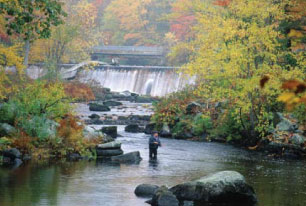Lamprey River History
The importance of history along the Lamprey was a key factor in the designation of the river into the National Wild and Scenic Rivers System. Human presence along the river goes back more than 8,600 years. Over time, the river has provided many resources, including fresh water, food, raw materials, power for mills, and more recently, recreational opportunites. The Lamprey River Advisory Committee has a video, "River Story: The Lamprey through History", that ties much of the river's rich history together in one package. To view it, please watch the following videos:
- Part 1: http://youtu.be/tQydbilDryA
- Part 2: http://youtu.be/MALMBfnmntk
- Part 3: http://youtu.be/YU2Vovq84wU
History is all along the river. Join us as we step back in time...
Pre-Colonial History
Archaeological studies of the Lamprey have shown that human presence along the river dates back more than 8600 years. Indigenous peoples were the original “summer people”, living inland in the winter and traveling to the Great Bay Estuary in summer. The people were probably from the Piscataqua or Squamscot tribes. They called themselves the Abenaki, or People of the Dawn, and belonged to the larger Algonquin group. The Lamprey, with its strong geographic connection to Great Bay, was a logical place to establish camps. The estuary provided abundant fish, shellfish, and water foul; all easily transported to camps via canoes on the river.
Early encounters with pre-colonial visitors from Europe often proved fatal for the Indigenous populations. The diseases brought by European hunters and traders took a heavy toll on people who lacked immunity. When colonists arrived to settle the land in 1623, the population of local peoples had already been reduced significantly.
Initially, relations between Indigenous and European peoples were friendly and based on trade. As more colonists arrived and shaped the land and relationships to meet their needs, conflicts grew between the two groups. By 1672, most Indigenous peoples had left the area and had moved to the Hudson River, near what would become Troy, New York.
The New Hampshire Division of Historical resources considers the Lamprey's riverbanks to be archaeologically sensitive and to have a strong potential to possess previously unidentified sites that were used by Indigenous peoples.
Shipbuilding and Shipping
Shipbuilding was an important industry in the lower Lamprey. In colonial times, tall, straight trees were cut and floated to Portsmouth to be shipped to England and used for masts. Later, several shipyards were located in Newmarket and Durham. At one point, a ship was built in Lee, taken apart, and then re-assembled in Newmarket. Sailing vessels unique to this area, flat-bottomed barges known as gundalows, were built in Newmarket, Durham, and elsewhere. They were utilized to transport goods among the Great Bay towns and Portsmouth. Later, a packet service carried cargo and passengers from town to town. These boats, 30-40 feet long, were made obsolete with the arrival of railroads.
Ice Harvesting
In the days before electric refrigeration, ice was a valuable commodity. The ice covering ponds and dam impoundments was cut into blocks by machines and hand tools, gathered, and stored in riverside storage houses. The crystal clear ice cakes were delivered to homes and businesses in the summer. Properly protected by sawdust, a block of ice could last all year. In one interesting example, patrons at Newmarket’s Star Theater were kept cool during summer shows with air that had been cooled in the Turcott Hardware ice house located below the theater.
Recreation and Tourism
Beginning in the early 1900s, people began to use the river as a place to relax and enjoy nature. Summer camps were built to give children an opportunity to learn new skills and have fun. Highland House in Durham hosted visitors from Massachusetts who came to enjoy the view, river-based recreational activities, and the quiet away from the city. Its offerings even included a pavilion in the middle of the river. Camp Hedding in Epping operated as a religious retreat and meeting place from 1862 through the 1880s. It was so busy, with up to 18,000 visitors per day, that it warranted construction of a branch railroad.
Industrialization
While earlier mills along the Lamprey River were small, the mills built in the mid 1800s became larger. At Wiswall Falls in Durham, a wooden paper mill was moved from Newmarket by oxen. This mill employed dozens of workers who operated machinery that churned out a ton of paper each day. The paper was shipped to Boston where it was printed to become decorative wallpaper. Two LRAC videos capture this story: Wiswall's Mill Part 1 and Part 2
In Newmarket, big mills became the huge mills of the Newmarket Manufacturing Company. These stone and brick mills housed equipment that made a variety of textiles that found markets far beyond New England. At one point, one of the mill buildings housed the largest weaving room in the world. The Newmarket Historical Society created a video in June 2022 that details the history of the Newmarket Manufacturing Company. Please click the link below:
History of The Newmarket Manufacturing Company - Newmarket Historical Society - YouTube
The Legacy of History
Dams and mills were tremendously important to the people of the Lamprey River. Most of the structures are gone now, but evidence of their presence abounds. As of 2020, three big dams and sections of breached dams remain on the lower Lamprey. The Macallen Dam in Newmarket is the highest dam and is a prominent feature of downtown Newmarket. It has had a fish ladder since 1972. The Wiswall Dam in Durham creates a drinking water reservoir for Durham and the University of New Hampshire. A fish ladder was completed here in 2012. The dam at Wadleigh Falls in Lee is breached, but it is still a formidable structure that migrating fish cannot get past. The Bunker Pond Dam at Folsom Falls in West Epping was removed in 2011.
Dams are important in local people’s memories and add to their sense of time and place. They require maintenance and can sometimes contribute to environmental problems, such as blocking fish passage. They also can be dangerous to people if and when they fail during flood conditions. The owners of dams, often towns, must weigh the costs and benefits of keeping or removing dams. Whenever a dam is repaired, replaced, or removed, significant considerations must be made to accommodate human safety, environmental effects, and historic value. To view a kiosk panel at Wiswall Falls that describes some of these issues, click here.
Like dams, mill sites often are important to local history. Visiting an old mill site and thinking back to the “old days” when life was very different from today can be a great learning experience; however, life then was not perfect. Mills were often loud, dangerous places to work. They poured their wastes into the river, significantly degrading water quality downstream and into Great Bay. Sediment cores taken from Great Bay show evidence of massive amounts of sawdust that were carried downstream of the many sawmills that dotted the Lamprey and other rivers. Other wastes from tanneries or foundries have accumulated behind dams and on former mill sites.
Today’s river, mostly forested and clean, has not always been this way. Through several cycles of clearing and reforestation, pollution and recovery, the Lamprey’s landscape has changed. The passage of the Clean Water Act in 1972, the designation of the Lamprey as a Wild and Scenic River, and the inclusion of the river in the NH Rivers Management and Protection Plan have all contributed significantly to the current state of the river. The river’s good condition is also the result of wide-spread and on-going efforts by people to protect the river’s assets, through local planning boards and conservation commissions, state and federal regulatory oversight, volunteer clean-ups, fundraising, education, and a balance between the needs of nature and the wants of people. The future of the Lamprey is largely dependent on how people recognize the past and use it today.


